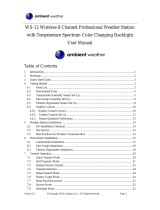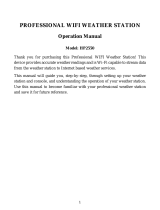Page is loading ...

High Precision Digital Rain Gauge
with Indoor Temperature and Humidity
Model: WH5360B
Thanks for your purchasing of the WH5360B High
Precision Digital Rain Gauge with indoor temperature
and humidity. To ensure the best product performance,
please read this manual and retain it for future reference.

1
1 Table of Contents
1 Table of Contents
...........................................................
1
2 Unpacking
.....................................................................
3
3 Set up Guide
..................................................................
4
3.1 Site Survey
.........................................................
5
3.2 Rain Gauge Sensor Set Up and Installation
.......
6
3.2.1 Install rain gauge filter
............................
7
3.2.2 Install rain collector top
..........................
8
3.2.3 Install Batteries in rain gauge sensor
......
8
3.2.4 Mounting
...............................................
10
3.3 Best Practices for Wireless Communication
....
12
3.4 Console Display
...............................................
15
3.4.1 Initial Display Console Set Up
.............
17
3.4.2 Key
........................................................
18
3.4.3 Normal Mode
........................................
20
3.4.4 Setting Mode
.........................................
21
3.4.5 Calibration Mode
..................................
21
3.4.6 Rain History Mode
................................
23
3.4.7 MIN/MAX Mode
..................................
23
3.4.8 Alarm Mode
..........................................
24

2
3.4.9 Factory Reset/Clear Memory
................
25
4. Features
......................................................................
26
5. Maintenance
...............................................................
28
6. Troubleshooting Guide
...............................................
30
7. Specifications
.............................................................
33
8. Warranty Information
.................................................
34

3
2 Unpacking
Open your rain gauge box and inspect that the
contents are intact (nothing broken) and complete
(nothing missing). Inside you should find the
following:
QTY
Item Description
1
Display Console
1
Rain gauge sensor
1
U-Bolts set for mounting on a pole (2pcs)
1
Threaded nuts for U-Bolts set (M5 size) (4pcs)
1
Metal mounting plate set to be used with U-Bolts
1
Stainless steel tube (for mounting the rain sensor)
1
Stainless steel filter (for rain collector)
1
User manual (this manual)
Table 1: Package content
If any component is missing from the package, or
broken, please contact our Customer Service
department to resolve the issue.

4
3 Set up Guide
Note: We suggest you assemble all components of the
rain gauge, including console in one location so
you can easily test functionality. After testing,
place the rain sensor in the desired location.
Note, however, that movement during assembly,
and movement after assembly can cause the rain
sensor to “falsely” register rain. It is possible to
reset the rain total to 0 via console.
Attention:
Follow the suggested order for battery
installation (outdoor sensor first, console last).
Ensure batteries are installed with correct polarity
(+/-).
Only use new batteries for all battery-operated
sensors.

5
3.1 Site Survey
Location of the outdoor sensor is paramount to good
data collection. Abbreviated instructions follow, but
for a detailed reference, see:
https://www.weather.gov/media/epz/mesonet/CWOP-
Siting.pdf.
Perform a site survey before installing the rain sensor.
Consider the following:
Ideally mounted at a height of 4 to 6 feet, or 1.5 to
2 meters above the ground.
Ideally located at a horizontal distance of 4 times
the height, above the rain gauge, of the nearest
obstruction.
Ensure the rain gauge is mounted level to the
ground, away from any horizontal surface that can
introduce rain-splashing or surrounding snow
buildup.
Note: If the rain gauge sensor was mounted less
than 3.3 feet or 1 meter above the ground,
the electromagnetic waves would be
absorbed by the earth when raining. Which
may cause inaccurate rainfall data
transmitting.

6
3.2 Rain Gauge Sensor Set Up and Installation
See Figure 1 to locate and understand all the parts of
the rain gauge sensor once fully assembled.
Figure 1: Sensor assembly components
1 Rain collector top
4 Battery compartment door
2 LED Indicator
5 Surface installation screw hole
3 Bubble level
6 U-bolt installation hole
Table 2: Sensor assembly detailed items

7
3.2.1 Install rain gauge filter
There’s a stainless steel filter included in the package.
It’s aimed to stop leaves or bird's dropping to avoid
the obstruction of the cone hole. The installation is as
simple as the below figures show:
Hook the filter hook on the edge of the rain collector
to install the filter(as the figure 2 shows on the left).
Take out the filter hook from the edge to uninstall the
filter(as the figure 2 shows on the right).
Figure 2: Rain gauge filter in/un-installation diagram
Hook the filter hook on the edge
to install
Take out the filter hook from the
edge to uninstall

8
3.2.2 Install rain collector top
Align the rain collector top with the rain bucket, pay
attention to the lock groove position as shown on the
left side in Figure 3. Next, lock the top clockwise to
the lock groove position, as shown on the right side of
the figure, until it comes to a stop and the top cannot
be removed from the bucket. Failure to do this may
cause the collector top to blow away in strong winds!
Figure 3: Rain collector top installation diagram
3.2.3 Install Batteries in rain gauge sensor
Remove the battery door on the back of the sensor by
sliding it in the direction of the arrow. Insert one AA
battery as described and put compartment door back
and slide it in the opposite direction to lock.

9
Figure 4: Rain gauge sensor battery installation
diagram
The LED indicator on the top of the battery door (item
2) will turn on for 4 seconds and then flash once every
49 seconds indicating sensor data transmission. If you
did not pay attention, you may have missed the initial
indication. You can always remove the batteries and
start over, but if you see the flash once every 49
seconds, everything should be OK.
Note: If no LED light up or is lighted permanently,
make sure the battery is inserted the correct way
or a proper reset is happened. Do not install the
batteries backwards. You can permanently
damage the outdoor sensor.
Lithium batteries are recommended for the best
performance. We do not recommend rechargeable
batteries. They have lower voltages, do not operate
well at wide temperature ranges, and do not last as
long, resulting in poorer reception.

10
3.2.4 Mounting
3.2.4.1 Before you mount
Before proceeding with the outdoor mounting detailed
in this section, you may want to skip to setup
instructions in section 3.4 and onwards first, while
you keep the assembled rain gauge sensor nearby
(although preferably not closer than 5 ft. from the
display console). This will make any troubleshooting
and adjustments easier and avoids any distance or
interference related issues from the setup.
After setup is complete and everything is working,
return here for outdoor mounting. If issues show up
after outdoor mounting they are almost certainly
related to distance, obstacles etc.
3.2.4.2 Mounting with U-bolts
The mounting assembly includes two U-Bolts and a
bracket that tightens around a 1-2" diameter pole
using the four U-Bolt and nuts. The package includes
a D32/H200 (diameter 32mm = 1.26”, length 200mm
= 7.87”) stainless steel tube for this purpose.

11
Figure 5: Rain gauge installation with U-bolts
Note: Use the bubble level one the side of the rain gauge
as a guide to verify that the sensor is leveled (for
proper measurements).

12
3.2.4.3 Mounting with screws
The mounting assembly also includes two screws for
installation on a flat surface.
Figure 6: Rain gauge sensor mounting with screws
installation diagram
Note: Use the bubble level beside the rain sensor as a
guide to verify that the sensor is leveled. Use
shims as necessary to achieve level installation.
3.3 Best Practices for Wireless Communication
Wireless (RF) communication is susceptible to
interference, distance, walls and metal barriers. We
recommend the following best practices for trouble
free wireless communication between both sensor and
the console:

13
Indoor/outdoor sensor placement: The sensor
will have the longest reach for its signal when
mounted or hung vertically. Avoid laying it down
on a flat surface.
Electro-Magnetic Interference (EMI). Keep the
console several feet away from computer
monitors and TVs.
Radio Frequency Interference (RFI). If you
have other devices operating on the same
frequency band as your indoor and/or outdoor
sensors and experience intermittent
communication between sensor and console, try
turning off these other devices for troubleshooting
purposes. You may need to relocate the
transmitters or receivers to avoid the interference
and establish reliable communication. The
frequencies used by the sensors are one of
(depending on your location): 433, 868, or 915
MHz (915 MHz for United States).
Line of Sight Rating. This device is rated at 300
feet line of sight (under ideal circumstances; no
interference, barriers or walls), but in most
real-world scenarios, including a wall or two, you
will be able to go about 100 feet.
Metal Barriers. Radio frequency will not pass
through metal barriers such as aluminum siding or
metal wall framing. If you have such metal

14
barriers and experience communication problems,
you must change the placement of sensor package
and or console.
The following table shows different transmission
media and expected signal strength reductions. Each
“wall” or obstruction decreases the transmission range
by the factor shown below.
Medium
RF Signal Strength Reduction
Glass (untreated)
5-15%
Plastics
10-15%
Wood
10-40%
Brick
10-40%
Concrete
40-80%
Metal
90-100%
Table 3: RF Signal Strength reduction

15
3.4 Console Display
See Figure 7 to help you identify elements of the console’s
display screen.

16
Figure 7: Display Console Screen Layout
1. Rainfall data display
8. Alarm icon
2. Rainfall grade graph
9. Date/Week
3. Rainfall of
day/week/month/year display
10. Signal icon
4. Time
11. Wall-mounted
hole
5. Rain rate/event/1h/24h display
12.Table stand
6. Indoor temperature
13. Battery door
7. Indoor humidity
Table 4: Display console detailed items

17
3.4.1 Initial Display Console Set Up
Immediately after power up (installing batteries), the
unit will turn on the display, and the unit will start to
look for reception of the outdoor sensor data. This
may take up to 3 minutes.
Figure 8: Console Normal Display

18
3.4.2 Key functions
Figure 9: Buttons next to the display
There is a set of five keys on the right side of the
display console. The following tables briefly explains
the function of these keys.

19
Button
Description
SET
enter the setting mode
RAIN 1/+
display RATE, EVENT, 1H, 24H
(normal mode) or + ( programming
mode)
RAIN 2/-
display DAY, WEEK, MONTH,
YEAR, TOTAL( normal mode) or–
( programming mode)
HISTORY
display history records / return to
normal mode
HI/LO
display the MAX, MIN value ( normal
mode) / Set Alarm ( hold the HI/LO
button to enter setting alarm mode)
Table 5: Console buttons
/





